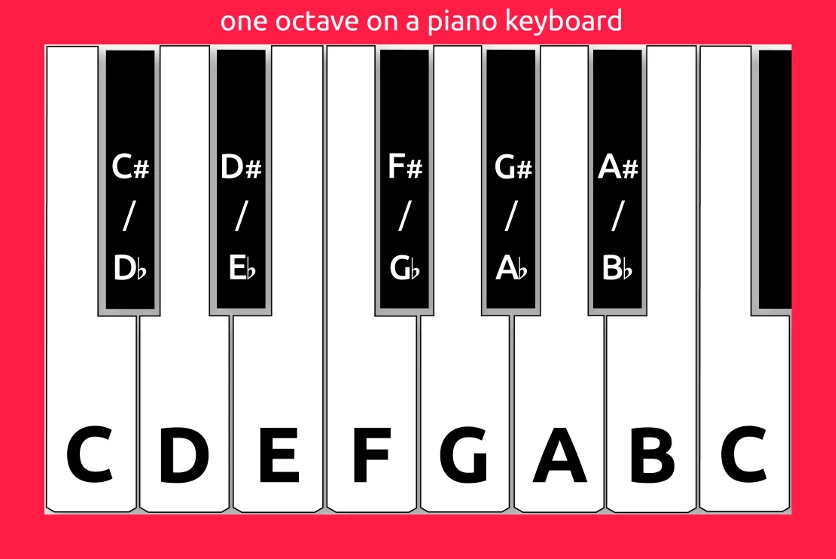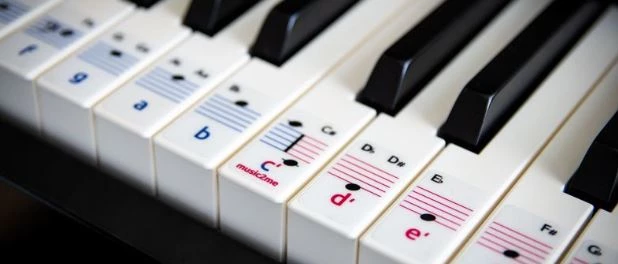There are many difficult piano pieces. We present five pieces that are so demanding that they were considered unplayable at times. Even today, they still demand skills from pianists that cannot be acquired through practice alone.

Founder and Piano teacher
One of the most important aspects of playing the piano is becoming accustomed to the keyboard, also known as the fingerboard. We’ll show how the piano keyboard is built, how the keys produce sound and what the white and black keys are all about. In addition, you’ll learn how to quickly get familiar with the keyboard.
Table of contents
A typical concert, digital, or electric piano has a keyboard with exactly 88 keys. The fingerboards of some electronic keyboards and instruments for beginners also have fewer keys. Many of these instruments have either 49 or 61 keys.
Keyboards are divided into groups of twelve keys, regardless of the total number of keys on the instrument. These twelve keys represent one octave. An octave is the distance between two notes that have the same name but different tonal sounds.
Therefore, the number of keys on a piano determines how often the group of 12 repeats on the piano keyboard. So you have a piano with fewer than 88 keys does not mean that you can play fewer notes. It just means that the same ones occur less often.
Imagine sitting at the piano, your fingers gliding effortlessly across the keys as you play melodies that move your heart. With music2me, you can learn piano at your own pace – step by step with a system that truly helps you progress, whether you’re a beginner or already advanced.
Over 400 video lessons & downloadable sheet music
Interactive tools like Skill Check & smart practice mode
Weekly live classes & personal teacher support
Exclusive Discord community for motivation & exchange
Let’s take a closer look at the of the twelve-note keys groups. A group contains seven white and five black keys.

The white keys are notes between the lines on a score sheet. The group of twelve on the piano traditionally starts at C, with other notes being D, E, F, G, A, and B.
The black keys are each labeled with two names. These notes are called „enharmonic equivalents“. This means that we’re practically dealing with the same note under different names.
Which of the two names the note takes depends on the context in which you play it, namely the key. To be clear: only sharp (#) or flat (♭) sings can appear in a key signature, but never both signs together. Therefore, ♭ the note between C and D can either be called C# or D♭.
This also explains why there is no black key between white keys in two places within the octave on the piano: there is only one semitone step between B and C and between E and F. As a result, the C is always on the white key to the left of the pair of black keys.
As you’ve probably realized by now, the C key plays an important roll in helping you find your way around the piano keyboard.
The C determines the beginning and end of an octave, i.e. the group of 12 keys described above.
In addition, many pieces that are often played by beginners are written in the C major scale. The reason for this is that the C major scale is the one with the least amount of note symbols, it has none at all. It is therefore easy to understand and it can be used to explain concepts of harmony.
To make it easier for you to learn the keyboard, we have prepared this PDF for you. It includes graphics across the entire keyboard of the piano and over the range of a single octave.
Tip: print out the diagrams and place them close to your musical instrument. That way, you’ll always have an overview at your disposal, and you can use it as a „cheat sheet“ to learn the names of the keys while practicing.
Of course there is also the premium version with matching sheet music stickers:

There are many difficult piano pieces. We present five pieces that are so demanding that they were considered unplayable at times. Even today, they still demand skills from pianists that cannot be acquired through practice alone.
Is it even possible learning to play the piano as an adult? Of course it is! Discover how to play piano at any age.
Vivaldis Four Seasons is probably his most famous piece. We provide you its genesis and Vivaldis history.